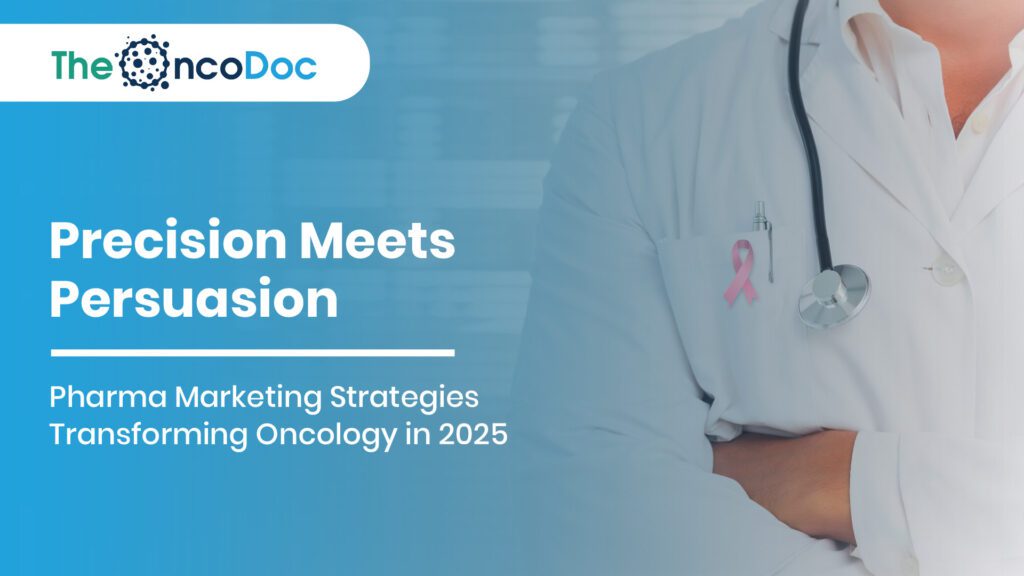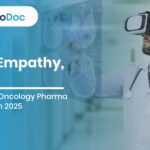Introduction: A Smarter, More Human Approach to Oncology Marketing
In 2025, oncology marketing is no longer defined by the number of prescriptions generated – it’s judged by the lives saved, the diagnoses made earlier, and the communities educated. With the rise of precision medicine, AI diagnostics, and real-world evidence (RWE) analytics, the pharmaceutical industry is shifting from product promotion to patient empowerment and clinician partnership.
Today’s cancer care ecosystem demands data intelligence, empathy, and hyper-personalized engagement. Oncologists, patients, and caregivers are flooded with medical information – but they act on messages that are relevant, timely, and trustworthy.
This article outlines 20 strategic pillars shaping oncology marketing in 2025, blending science, storytelling, and smart technology to achieve maximum impact.
1. Patient-First Messaging Beyond the Clinic
While oncologists remain central decision-makers, the patient’s voice has grown louder. Campaigns now:
- Provide clear, non-jargon resources in multiple languages.
- Address emotional fears surrounding diagnosis and treatment.
- Showcase real-life survivor journeys to inspire action.
This shift is about empowerment, not persuasion. By offering content that speaks to a patient’s emotions and needs, pharma brands help reduce anxiety at the most vulnerable stages. The trust built during these moments often translates into stronger doctor-patient alignment, where the treatment pathway is embraced rather than feared. In this way, marketing becomes a form of patient advocacy.
2. Data-Intelligent Market Segmentation
Gone are the days of one-size-fits-all marketing.
AI now sorts oncology audiences by:
- Cancer type prevalence in specific regions.
- Digital behavior (search trends, symptom-related queries).
- Socioeconomic barriers to screening and treatment.
Advanced segmentation means campaigns can target specific community health challenges – like urban breast cancer screening or rural oral cancer awareness – with precision. The result is less wasted ad spend and higher conversion rates. By mapping these data layers, marketers can predict the best timing, format, and message for every micro-audience.
3. The GP Connection – A Referral Goldmine
General practitioners (GPs) remain the frontline identify for cancer symptoms Yet, many miss early detection cues. Pharma marketing now invests in:
- Microlearning videos for busy GPs.
- Instant CME access via WhatsApp.
- Diagnostic toolkits that streamline decision-making.
By arming GPs with concise, case-based learning modules, brands help boost early referrals. Many companies now sponsor regional GP networks that share patient case discussions, ensuring broader exposure to early warning signs. This proactive approach doesn’t just improve marketing ROI – it directly saves lives.
4. Omnichannel Engagement That Feels Personal
Patients and clinicians expect seamless information flow between online and offline channels. Winning campaigns integrate:
- Social storytelling on Instagram and Facebook.
- Using mobile apps, push notifications are used to remind users to screen.
- In-clinic kiosks offering educational videos.
When messages follow the audience across devices and contexts, they become part of their daily lives rather than isolated ads. This approach also shortens the decision-to-action gap, especially for time-sensitive screenings. The key lies in maintaining a consistent brand tone while adapting content to each channel’s strengths.
5. Behavioral Nudging for Preventive Action
Marketing grounded in behavioral science nudges patients toward early action. Examples:
- Screening reminders tied to awareness months.
- Gamified quizzes encouraging symptom awareness.
- Small incentives like free check-up vouchers.
These nudges tap into human psychology, making healthy actions feel rewarding and urgent. Over time, this approach normalizes preventive screenings within communities. Campaigns that combine nudges with local influencer voices often see participation rates jump significantly.
6. Survivor-Led Storytelling That Builds Trust
In oncology, emotional connection outperforms clinical data when motivating preventive action. Survivor stories:
- Achieve 40% higher engagement than generic content.
- Inspire peer-to-peer sharing.
- Reduce stigma and fear around diagnosis.
Storytelling rooted in lived experience resonates across cultural and age groups. It also gives campaigns a sense of authenticity and hope that traditional ads cannot match. When survivors become brand advocates, they naturally extend the campaign’s reach through their own networks.
7. AI-Powered Content Personalization
AI marketing platforms now match the right message to the right person:
- A 40-year-old woman searching for “breast lump” gets self-exam guides.
- A rural smoker sees oral cancer screening camp details in their local language.
This hyper-targeted delivery ensures that audiences receive only what’s relevant, reducing information overload. AI also monitors engagement patterns, allowing campaigns to auto-adjust if messages are ignored or misunderstood. The outcome is higher engagement and better screening uptake.
8. Vernacular and Cultural Localization
Localization goes beyond translation – it adapts messaging to cultural context.
Example:
- In Tamil Nadu – breast cancer awareness videos in Tamil with local survivor advocates.
- In Assam – oral cancer campaigns delivered via folk theatre and community radio.
By respecting local customs and communication styles, campaigns gain trust faster. This also improves message comprehension in communities with low literacy. As a result, health messages are more likely to inspire tangible action.
9. Digital Toolkits for Oncologists
Pharma companies now deliver clinician-focused platforms with:
- AI-curated journal digests.
- Patient adherence tracking.
- Peer discussion boards for rare cancer cases.
These toolkits position brands as knowledge enablers, not just product suppliers. By streamlining information flow, they also help oncologists stay updated with minimal time investment. This builds goodwill and makes clinicians more likely to engage with brand initiatives.
10. KPIs That Track Health Outcomes, Not Clicks
Success is now measured in health impact metrics, such as:
- Screenings booked.
- GP referral uptick.
- Symptom checker engagement.
Tracking real-world impact shifts focus from vanity metrics to meaningful outcomes. Campaigns that report such data also earn regulatory and public trust, further cementing their reputation. Over time, this results in more sustainable brand growth.
11. KOL Partnerships That Drive Action
Collaborating with local key opinion leaders – respected oncologists, survivor influencers, or grassroots physicians – boosts credibility. Micro-influencers often outperform celebrity endorsements in healthcare.
These partnerships work best when rooted in long-term relationships, not one-off campaigns. KOLs can also shape messaging to ensure it resonates with medical peers while remaining accessible to the public. The result is a marketing approach that feels less like advertising and more like trusted advice.
12. Predictive AI Campaign Triggers
AI scans search data, patient records, and social chatter to predict cancer awareness needs in specific geographies.
For example:
- Spike in “persistent cough” searches in a city triggers lung cancer awareness ads within days.
This predictive layer allows campaigns to be proactive rather than reactive. By targeting communities before a health crisis peaks, brands position themselves as responsive allies. It also optimizes marketing spend by deploying resources where they are most likely to make an impact.
13. Gamification for Awareness and Engagement
Cancer awareness is now interactive:
- Risk quizzes give a personal “health score.”
- Community challenges reward highest screening participation.
- Digital badges for screening completion shared on social media.
Gamification transforms passive awareness into active participation. It also taps into community pride, motivating people to compete for wellness rather than ignore symptoms. For pharma marketers, it’s a way to sustain engagement beyond the initial campaign period.
14. Wearable Device Integration
Pharma apps now sync with wearables to:
- Monitor vitals and lifestyle metrics.
- Send alerts for abnormal readings.
- Suggest screenings when patterns change.
By linking wearable data with oncology campaigns, brands can deliver timely, highly relevant prompts. Patients who receive health alerts from a trusted app are more likely to take action quickly. This integration also helps collect anonymized data for future campaign optimization.
15. Cross-Sector Partnerships
Joint efforts with NGOs, government agencies, and hospitals:
- Extend rural reach.
- Reduce operational costs.
- Improve public trust.
Such partnerships often lead to co-branded initiatives that share funding and resources. This not only stretches marketing budgets but also creates multi-channel credibility. When a campaign carries both a government health seal and a pharma logo, it’s perceived as more trustworthy by the public.
16. Digital Patient Communities
Online spaces moderated by health professionals:
- Host live Q&As with oncologists.
- Offer emotional support groups.
- Share treatment journey guides.
These communities foster peer-to-peer encouragement, making patients feel less isolated. They also provide brands with first-hand insights into patient challenges and misconceptions. Over time, these spaces can evolve into loyalty ecosystems, where members naturally advocate for the brand.
17. Voice Tech for Low-Literacy Populations
Voice-first tools make awareness accessible to all:
- IVR hotlines answering cancer FAQs.
- Voice-based chatbots on WhatsApp in regional languages.
- Smart speaker sessions in community halls.
This approach breaks literacy and digital barriers, allowing outreach to populations otherwise excluded from health campaigns. It also scales efficiently – one recorded message can educate thousands without needing constant staff intervention. In remote areas, voice tech often becomes the primary health education channel.
18. Emotional Analytics to Refine Messaging
AI sentiment tools scan audience reactions and adjust tone in real time – ensuring campaigns motivate without fearmongering.
These analytics track everything from emoji use in comments to tone of social media posts. If a message is generating confusion or negativity, it can be replaced within hours. This agile approach ensures campaigns remain emotionally aligned with audience needs and expectations.
19. Survivor Clubs as Local Awareness Leaders
Survivor-led community groups:
- Conduct school workshops.
- Partner with local clinics.
- Lead public awareness drives.
The authenticity of survivor voices makes these clubs powerful local influencers. They not only share stories but also demonstrate preventive behaviors, setting community examples. Many pharma brands now sponsor these clubs as long-term grassroots ambassadors.
20. AR/VR for Clinician Education
Immersive oncology training with 3D tumor modeling and VR surgical simulations keeps oncologists ahead in rare cancer treatments.
By offering hands-on virtual experiences, pharma companies help clinicians retain knowledge better than with traditional CME formats. It also positions brands as leaders in educational innovation. This type of training often leads to stronger professional loyalty toward the sponsoring company.
Conclusion: A Future Where Marketing Equals Medicine
In 2025, oncology marketing is medicine’s ally – driving earlier diagnoses, informed decisions, and better patient outcomes. The brands leading this charge combine data precision, cultural empathy, and genuine human connection.
The winners will be those who measure success not by ad impressions, but by screenings conducted, referrals made, and lives saved. Marketing in oncology is no longer about being the loudest voice – it’s about being the most trusted partner in the fight against cancer.
By weaving together AI-driven insights, cultural intelligence, and survivor-driven authenticity, the future of oncology marketing will be both smarter and more human than ever before.
The Oncodoc team is a group of passionate healthcare and marketing professionals dedicated to delivering accurate, engaging, and impactful content. With expertise across medical research, digital strategy, and clinical communication, the team focuses on empowering healthcare professionals and patients alike. Through evidence-based insights and innovative storytelling, Hidoc aims to bridge the gap between medicine and digital engagement, promoting wellness and informed decision-making.



